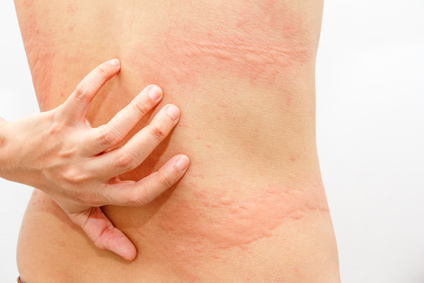- Home
- Urticaria
Types of Urticaria
Visit this
PICTURES OF RASHES PAGE
Urticaria describes a skin condition that is characterized by the development of various types of extremely itchy and swollen red bumps or patches on the skin. These patches or hives may appear suddenly as a result of the body’s adverse reaction to certain allergens. The skin on any part of the body including the face, lips, tongue, throat or ears is vulnerable to this condition. The hives that appear can vary in size and can last for only a few minutes or for several days.

There are several different types of urticaria. Although the different types are all related, they do produce varying symptoms. Sometimes an individual may have more than one type. Described below are descriptions for acute, chronic, drug-induced, and physical urticaria.
Acute Urticaria
The acute variety usually becomes evident a few minutes after contact with the allergen. The reaction may last from a few hours to several weeks, but usually less than six weeks. Typically, the hives are evident only for a few days. Reactions as a result of food allergens typically cause the acute form of this skin problem, but for about half the cases the cause is usually not found. Common foods that act as triggers are: shell fish, nuts, eggs, fish, acid derivatives, and certain food dyes. Other allergens can be antibiotics, bee or wasp stings or skin contact with certain fragrances.
This type can occur with anaphylaxis – a severe allergic response leading to difficulty in breathing and possible death.
Chronic
The chronic type is characterized by hives that appear daily or almost daily for at least six weeks or more. Visually, both acute and chronic forms of the disease are the same. The problem is that the chronic form can persist for a long time. More severe cases can last up to 20 or more years. An identifiable cause for the problem is rarely found.
Drug-Induced
Drugs that have caused allergic reactions manifesting as urticaria include: aspirin, penicillin, sulfonamides, anti-convulsants, and anti-diabetic drugs such as suphonylurea.
Physical
Dermatographism or Dermographism
Dermatographism is the appearance of wheals or welts on the skin as a result of rubbing, scratching, or firm stroking of the skin. It is the most common form of physical urticaria. The skin reaction usually appears soon after the rubbing and disappears within 30 minutes. For more information on dermatographism, please return to the dermatographism page.
Pressure or Delayed Pressure
This type can occur immediately after a pressure stimulus or as a delayed response to sustained pressure being applied to the skin. In the delayed form, the hives only appear after about six hours from the initial application of pressure to the skin. Generally, these hives are not the same as those found with most urticarias. Instead, the swelling in the affected areas is typically more diffuse. The hives may last from about 8 hours to three days.
The source of the pressure on the skin can be from tight fitting clothing, belts, bra straps, walking, leaning against an object, standing, sitting on a hard surface, etc. The areas of the body commonly affected are the hands, feet, the trunk, the buttocks, legs, and the face.
Although this appears to be very similar to dermatographism, the main difference is that the raised skin areas do not appear quickly and tend to last much longer. This form of the disease is rare.
Cholinergic or Stress (Adrenergic)
This form is fairly common and occurs with exercise, sweating, or any activity that leads to a warming of the core body temperature such as warm or hot baths or showers. The hives that are produced are typically smaller than the classic hives. In severe cases, hundreds of tiny red itchy spots appear on the skin with exercising, when the individual is warm or when the individual is stressed. The red spots appear rather quickly and remain for about 60 to 90 minutes on average.
Cold
Cold hives are caused by exposure of the skin to cold temperatures. In particular, the hives appear on the skin areas that have been exposed to cold, damp, and windy conditions.
Heat
This rare form is triggered by the application of heat on the skin. Hives develop within 2 to 5 minutes on the area of the skin that was exposed to heat. The hives usually do not last more than an hour.
Solar
This is a rare form of the disease and is caused on areas of the skin that have been exposed to the sun. The skin condition becomes evident within minutes of the sun exposure. After the individual is no longer exposed to the sun, the condition starts to fade within a few minutes to a few hours and rarely lasts longer than 24 hours.
Water (Aquagenic)
This type is very rare and occurs upon contact with water. The reaction is not temperature dependent and the skin appears similar to cholinergic form of the disease. The appearance of hives is within 1 to 15 minutes of contact with the water and can last from 10 minutes to two hours.
If you are looking for a couple of natural options to combat this urticaria skin problem please see the link below.
Recommendations for urticaria treatment.
Other Resources
